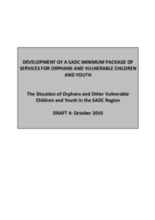EXECUTIVE SUMMARY
The SADC region has an estimated 250 million people among the Member States. In each Member State more than 50% of the population is under the age of 18. These children need care, protection and support. Unfortunately for many, vulnerability does not end when they leave childhood. Many youth continue to be at risk. Poverty is endemic and employment scant. Many youth have limited training, are unable to find work, and potentially engage in risky coping strategies to survive. Certain groups are even more vulnerable. Young women aged 15-24 are three to four times more likely to be infected by HIV. Children and youth with disabilities are often on the margins of society. For these reasons, SADC has determined that it is more meaningful to attempt to address the needs of orphans and vulnerable children and youth (OVC & Y) collectively.
This review found that there is lot of good practice within the region, and significant progress has been made in the realm of policy improvements for orphans and vulnerable children. However there are still some significant gaps and there remains a substantial disconnect between policy into practice. Critically, younger children, and children and youth with disabilities are largely overlooked in many programmes, and there is no continuation of service provision for vulnerable youth once they reach the age of 18 years. Too many youth are not realising their rights. Certain groups of vulnerable children remain on the margins, for example services for children living on the streets and in institutions are largely absent within most National Plans of Action for OVC. Dual legal systems and resultant conflicts between statute and traditional law in 14 out of 15 SADC Member States make upholding of children’s and young women’s rights almost impossible. Protection of married girls, pregnant girls and unmarried mothers is another area not addressed adequately.
To this end, SADC is developing a Minimum Package of Services for Orphans and Vulnerable Children and Youth which will draw on existing experience and lessons learned from the region and documented in this situational analysis. The situation analysis is drawn from a comprehensive desk review and fieldwork in 13 of the 15 SADC Member States. The Minimum Package will make locally relevant, age and gender specific recommendations for needs-based service delivery for OVC & Y that includes a continuum of services from pre-birth to twenty-four years and that responds to the specific needs of most at-risk boys and girls. The Minimum Package will also identify gaps in current service delivery and areas for further study.
Six key core service areas emerged during the situation analysis that will serve as the framework for the Minimum Package. These are education, food security and nutrition, health, protection, social protection, and psychosocial support. In addition a number of cross cutting themes emerged and will need to be accounted for in each of the key areas of intervention. The cross cutting themes represent specific areas of consideration that are common across all of the sectors. The cross cutting themes are: HIV and AIDS, gender, children with disabilities, child and youth participation, adolescents and youth and emergencies.
This situation analysis also contextualises the current response for OVC & Y within the existing international, regional and national policy environments. The policy environment across the region is very robust and generally supportive of vulnerable children and youth, however some international and regional agreements remain unsigned by Member States. Ratification or adoption of child and youth related protocols, such as the African Youth Charter and the ACRWC is a helpful first step in increasing the focus on children and youth within national governments, however this does not necessarily translate to improved conditions for children on the ground. The Minimum Package will help to assist national governments to ensure that such agreements can result in tangible change for orphans and vulnerable children and youth.
This Situation Analysis Report is one of a series of three documents: (1) Report on the Situation of Orphans and Vulnerable and Children and Youth in the SADC Region; (2) Conceptual Framework for Psychosocial Support for Orphans and Vulnerable Children and Youth in the SADC Region; and (3) Minimum Package of Services for Orphans and Vulnerable Children and Youth in the SADC Region. The Situation Analysis Report has informed the development of the PSS Framework and the Minimum Package of Services.

